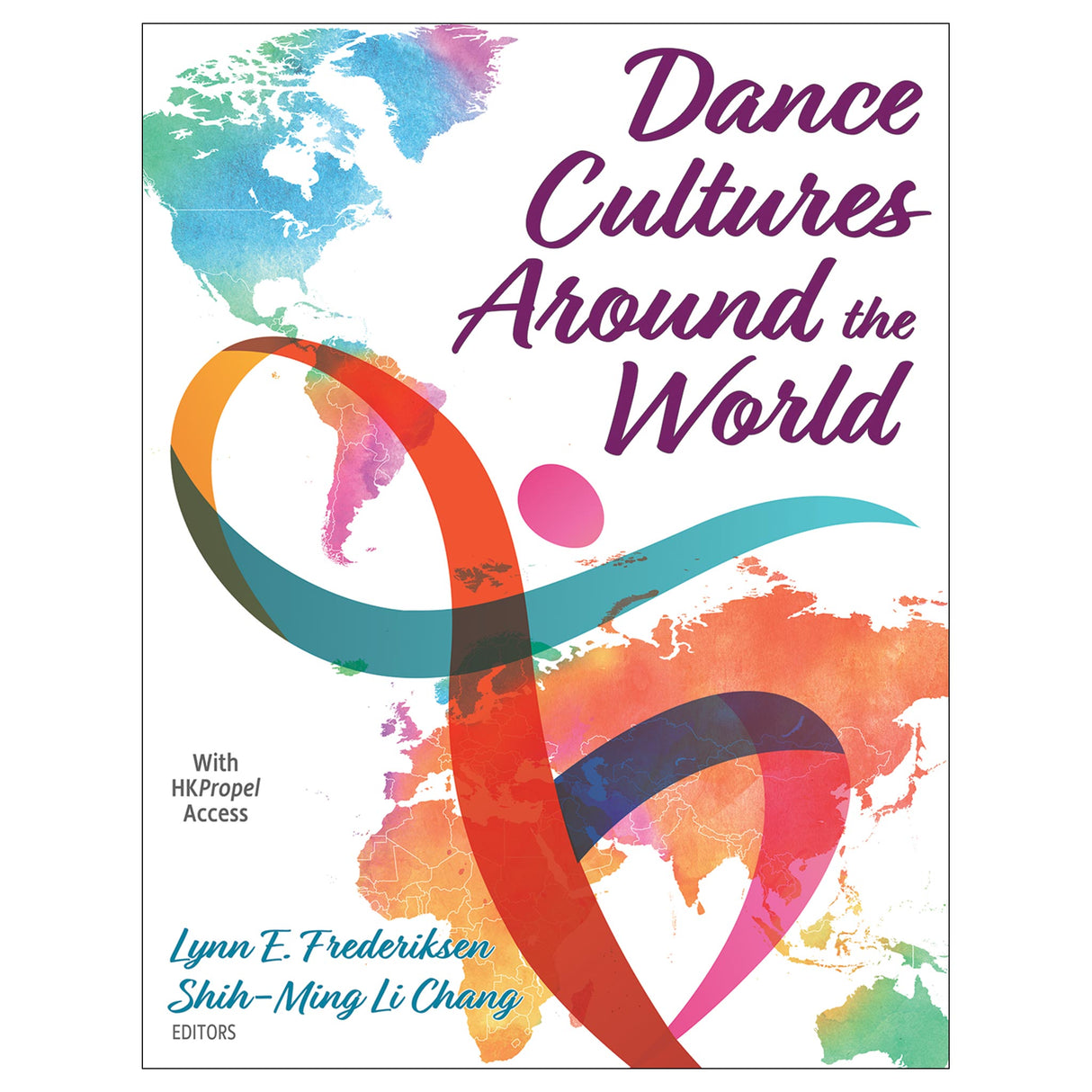Dance Cultures Around the World Ebook With HKPropel Access
$88.00 USD

As stated in the preface, “Every culture has some form of dance. However, why people dance—and further, how they define and create dance—are the difficult questions at the core of this text. Once you understand why dance exists and examine the factors that explain particular dance forms, you can engage more fully with many cultures of dance, including your own.”
Written by cultural insiders, the chapters illuminate contexts and histories of dances often misinterpreted through the notion of dance as a universal language. “Just as you would not expect to understand a foreign language simply because it is human speech, you cannot expect to understand foreign dance without some ‘translation.’ The multiple layers of meaning and history in foreign dances are often left unrevealed, and therefore the opportunity for true cross-cultural understanding is missed.” To ensure rich cross-cultural engagement, the insiders “translate” their dance cultures, showing how influential forces affect both the qualities of the dance and its place in society.
Dance Cultures Around the World offers a wealth of information:
- It explores dance cultures in nine geopolitical regions.
- It reveals patterns that operate in each region, adjusting for historical, political, and geographical differences.
- It enriches the reader’s experience of their own culture, as well as those of others, as they learn what dance is in various cultures, who dances, and why they dance.
Instructors and students have access to online resources through HKPropel. Instructor resources include a sample syllabus, chapter summaries, and suggested answers for chapter discussion questions; a presentation package with PowerPoint slides; a test package with over 700 multiple-choice, true-false, and fill-in-the-blank questions; and ready-made chapter quizzes. Student resources include links to videos, articles, and websites for further learning; key terms and definitions; references and resources; an application activity for each chapter; and chapter quizzes.
Dance Cultures Around the World gives readers an overview of dance cultures and provides an insider’s perspective on how dance develops and evolves around the world. Together with the online resources in HKPropel, the book gives students and instructors a well-crafted gateway to dance cultures across the globe.
Note: A code for accessing HKPropel is included with this ebook.
Audience
Text for general education and dance courses at undergraduate and high school levels.Chapter 1. Native American and First Nations Dance
Robin Prichard
Studying Native American Cultures
History of Intertribal Powwows
Powwow Elements
Powwow Dances
Crosscurrents
Summary
Chapter 2. Social Dance in the United States
Nora Ambrosio
Brief History
Social Dance
Social Dance as Expression
Social Dance for Socialization
Crosscurrents
Summary
Chapter 3. Danza Folklórico and Mexican American Culture
Colleen Porter Hearn
Ever-Evolving Dances of Ancient Culture
Spanish Conquest and Colonialism
Mexican Nation
French Occupation of Mexico
The Mexican Revolution
Crosscurrents
Folklórico as Integrative Learning
Summary
Part II. Central and South America
Chapter 4. Dance in Guatemala
Beatriz Herrera Corado
Creating Identity
Dance as a Calendrical Event
Continuity of Mayan Practices
Colonial Period
The Garífuna
Influences From Western Theatrical Dance
Crosscurrents
Summary
Chapter 5. Dance in Brazil
Amélia Conrado
Geography and History
Dance and Ritual in Pre-Brazil
European Dances in Brazil
Founding of Modern Dance in Brazil
Regional Dances and Popular Cultural Events
African Dance in Brazil
Crosscurrents
Summary
Part III. Caribbean
Chapter 6. Bèlè Drum-Dance Culture in Martinique
Camee Maddox-Wingfield
Defining Bèlè as a Regional Folk Tradition
Question of Origins
Bèlè Performance Contexts in Contemporary Martinique
Bèlè’s Pre-Revival Eclipse in Martinique
Bèlè’s Revitalization, Cultural Activism, and Pedagogy
Annual Holidays and Observances
Crosscurrents
Summary
Chapter 7. Dance in Trinidad and Tobago
Elizabeth Fernández O’Brien
History and Carnival as a Trini Identifier
Neo-African Dance in Trinidad and Tobago
From Ritual to Performance
Indo-Trinidadian Dance Traditions and Development
Other Cultural Infusions
Crosscurrents
Summary
Part IV. Africa
Chapter 8. Dance in Ghana
Jennies Deide Darko
Brief History
Crosscurrents
A Multiplicity of Customs
Traditional Dances From Ghana
Social Dance
Ceremonial Dance
Summary
Chapter 9. Dance in Uganda
Ronald Kibirige
Brief History
Dancing and Dance-Musicking
A Communitarian Approach to Coexistence
Activation of Individual and Community Human Social Capital
Crosscurrents
Summary
Chapter 10. Dance Cultures of Zimbabwe
Solomon Gwerevende
Brief History and Geography
Indigenous Zimbabwean Dances
Characteristic Features of Indigenous Dances
Crosscurrents
Implications of Modernity and Globalization
Summary
Part V. Europe and Russia
Chapter 11. Dance in Irish Culture
Sharon Anne Phelan
Brief History
Irish Dance Culture From the 13th Century CE
Dance During the Colonial Era
Dance at the Turn of the 20th Century
Dance During the Postcolonial Era
Theatricalization of Irish Dance in Ireland
Crosscurrents
Summary
Chapter 12. Dance in Spain
Bridgit Luján
Flamenco
Spanish Dance and Flamenco
Crosscurrents
Summary
Chapter 13. Dance in Croatia
Tvrtko Zebec, Ivana Katarinčić, and Iva Niemčić
Social Context
Central and Southeastern European Influences
Regional Styles of Dance and Music
Legacies of Cross-Cultural Trade and Travel
Institutionalized Dance Education
Crosscurrents
Summary
Chapter 14. Dance in Greek Culture
Christos Papakostas and Nick Poulakis
Brief History and Geography
Ancient Dance (800-146 BCE)
Theatrical Dances of the Classical Period
Greek Dance in the Middle Ages (146 BCE-1453 CE)
Early Modern Dance (1453-1821)
Traditional Dance in Modern Greece (1821-Present)
Popular Dance
Contemporary Art Dance
Crosscurrents
Summary
Chapter 15. Dance in Bulgarian Culture
Iliana Petrova Salazar
Bulgarian Dance Culture
The Horo
Folk Dance Education and Bulgarian Music
Crosscurrents
A New Choreographic Culture
Summary
Chapter 16. Traditional Dance in Russia
Anthony Shay
Brief History
Ethno Identity Dance and Socialist Realism
Russian Folk Dances in the Field
Three Russian Folk Dances
Russian Ethno Identity Dance
Crosscurrents
Summary
Part VI. Middle East
Chapter 17. Dance Cultures of Turkey
Zeynep Gonca Girgin
Brief History
Traditional Folk Dance
Classical Dance
Religious Movement Systems
Crosscurrents
Summary
Chapter 18. Dance in Iran
Nathalie M. Choubineh
Myths and Assumptions of Persian Dance
Historical Highlights
Modernization of Iran
Islamic Revolution of 1979
Crosscurrents
Summary
Part VII. South and Southeast Asia
Chapter 19. Indian Dance
Justine Lemos
Brief History
Classical Dance
Tradition and Reconstruction
Crosscurrents
Summary
Chapter 20. Dance in Indonesia
Abdul Haque Chang
Crosscurrents
Diversity of Indonesian Dance
Ancestor Worship, Trance, and Religion
Jathilan Trance Dance
Revival of Traditional Dance Arts
Summary
Chapter 21. Dance in the Philippines
Desiree A. Quintero and Wayland Quintero
Place-Based Dance Practices
Music and Dance
Acapulco-Manila Galleons and the Melding of Forms
Dance as Part of Festivity
The “Mother” of Philippine Folk Dance
Indigenous Peoples
Kapwa
Crosscurrents
Summary
Part VIII. East Asia
Chapter 22. Dance in Chinese Culture
Shih-Ming Li Chang and Lynn E. Frederiksen
Dance in Chinese Culture Over 5,000 Years of History
Classical Dance
Chinese Folk Dance
Martial Arts, Competition, and Military Dance
20th-Century Political Turmoil
Chinese Civil War
Yangbanxi
Zhongguogudianwu
Paths to Contemporary Dance
Crosscurrents
Summary
Chapter 23. Dance in Japanese Culture
Inoue Atsuki
Matsuri
A Confluence of Cultures
Japanese Aesthetics
Kagura
Noh and Kabuki Theater
Folk Dance of Indigenous People in Hokkaido and Okinawa
Crosscurrents
Popular Dance in Contemporary Japan
Summary
Part IX. Oceania
Chapter 24. Dance of Aboriginal Australia
Stephen A. Wild
Aboriginal Culture
Rom in Northern Australia
Other Contexts of Dance in Arnhem Land
Central Australia
Other Traditions of Aboriginal Dance
Crosscurrents
Summary
Chapter 25. Dance in Tahitian Culture
Jane Freeman Moulin
Brief History
The Colonial Institution
Creativity and Innovation
Crosscurrents
Summary
Shih-Ming Li Chang is a choreographer, performer, educator, author, and emeritus associate professor of dance at Wittenberg University. She earned her BA in dance at the University of Chinese Culture in Taiwan and her MFA in dance at Smith College. At Wittenberg Ms. Chang taught ballet, modern, jazz, Chinese classical and folk dance, and dance composition and dance ethnology, and she directed Wittenberg's annual dance concert. While serving as chair of the theater and dance department, Chang hosted the 2019 ACDA East-Central conference at Wittenberg, and throughout her career she developed cultural festivals both on and off campus. Over the years Chang has given lectures and demonstrations on Chinese dance and culture in numerous universities, festivals, and conferences in Taiwan, Poland, and the United States. As a performer, Chang danced with Van Pelt Dance and also presented her own solo works in many venues. Chang served on the boards of directors of OhioDance, the Ohio Alliance for Arts Education, and American College Dance Festival Association. She also was executive director for Weaving Pine—a nonprofit organization promoting Chinese Culture and performing arts in Ohio.
Chang and Frederiksen coauthored the book Chinese Dance: In the Vast Land and Beyond (Wesleyan University Press, 2016) as well as an article on Chinese dance in Encyclopedia of Modern China (2009) and “Dance Is the Prism: A Collaborative Journey Through Chinese Dance” in Taking a Bite of the Big Apple: Exploring Resources to Promote Best Practices (NDEO 2009 Conference Proceedings).
All ancillaries are free to adopting instructors through HKPropel.
Instructor guide. Includes a sample syllabus and chapter-specific files that contain chapter summaries and suggested answers for the discussion questions.
Test package. Contains over 700 questions in multiple-choice, true-false, and fill-in-the-blank formats. The files may be downloaded for integration with a learning management system or printed for use as paper-based tests. Instructors may also create their own customized quizzes or tests from the test bank questions to assign to students directly through HKPropel. Multiple-choice, true-or-false, multiple-response, and matching questions are automatically graded, and instructors can easily review student scores in the platform.
Chapter quizzes. Ready-made chapter quizzes allow instructors to assess student comprehension of the most important concepts in each chapter. Each quiz contains 10 questions, drawn from the larger test bank. Each quiz may be downloaded or assigned to students within HKPropel. The chapter quizzes are automatically graded, with scores available for review in the platform.
Presentation package. Contains PowerPoint slides of the key points of each chapter. Instructors can use these slides just as they are or edit them to create unique presentations.
Instructors also receive access to all student materials in HKPropel. For Dance Cultures Around the World, this includes key terms and definitions, application activities, and links to videos, articles, and websites.









